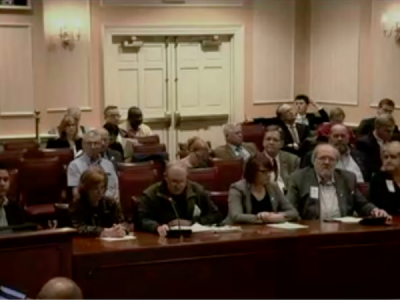
Posted on February 7, 2019
ANNAPOLIS — Senate Bill 145, (SB145) legislation that would prevent the Maryland Department of Natural Resources from dredging oyster shells near the Man-O-War shoal, was met with support and opposition at the Maryland General Assembly Tuesday, Feb. 5.
Sen. Kathrine Klausmeier, who sponsored the bill, said prevention of dredging would protect a treasure of the Chesapeake Bay, in Man-O-War shoal.
“Personally, I believe it’s the last shoal in the Chesapeake Bay, and once it’s gone, none of us are going to see another one,” Klausmeier said.
Baltimore County Maryland Waterman Association Director Blair Baltus said Man-O-War shoal was the last oyster shoal on the Chesapeake Bay for use by waterman in Baltimore County. He said with the pollution from Conowingo Dam in Pennsylvania in 2018, multiple factors have affected the oyster population.
Continuing to affect the population with dredging will sacrifice more areas oysters can grow naturally, he said.
“There has been no decision on how the shell will be distributed between sanctuaries, public’s harvest bars and aquaculture areas or the cost of the shell,” Baltus said. “If this plan goes through, and 30 million bushel of shells is eventually dredged from the shoal, all we will be left with is a destroyed natural bar and silt filled holes. … Now we will be asked to give up more bottom forever.”
Allison Colden, a Maryland fisheries scientist for the Chesapeake Bay Foundation, said part of the issue with dredging is the materials used. Alternative substrate is often more durable and longer lasting for replacing oyster population, whereas natural shells may only have a few years of use.
Colden said by cutting into the core of the shoal through dredging, oxygen and other forces will accelerate the depletion of the reef over time.
“Shell reefs built less than twelve inches are silted over and degraded over time. These bars are not built to last. Which means the two, three maybe five if we’re lucky, years from now, we’ll be sitting here having this same conversation, … Dredging Man-O-War shoal is simply not a durable solution.”
Maryland Waterman’s Association Board Members from various counties, including Dorchester, Kent and Queen Anne’s Counties, all came to express their opposition of the halting of dredging at Man-O-War shoals.
Robert Brown, president of the Maryland Waterman’s Association said watermen had been dredging in the way proposed in SB145 since the expansion of the spat restoration program in the 1960s.
“The shell is so valuable to us,” Brown said. “To do a 20 acre seed area it takes close to 400,000 bushels of shells to do it. … Then you leave it for the public to work in that area.”
Brown said often, shells that are dredged do better for anchoring spat than fresh shell. Brown said waterman need a seed area for the Bay in order to restore more of the oyster population.
Talbot Waterman’s Association President Jeff Harrison said dredged shells are essential for restoring populations of oysters in the Chester River.
“From 1985 until 2002, the oyster harvest in the Chester River was somewhere between 20,000 to 70,000 bushels,” Harrison said. “The spat numbers from those same years never got higher than 16 per bushel, with 11 years being 0.”
Source: stardem





